Live from Milan: ATP Media and Gearhouse Broadcast test 1080p/50 HDR workflow at Next Gen ATP Finals
ATP Media, the broadcast arm of the ATP World Tour, has successfully produced and distributed a 1080p/50 HDR test feed at the 6-10 November Next Gen ATP Finals. The 1080p/50 HDR production generated the 1080i SDR feeds that were globally distributed.
The Next Gen tournament is the ATP Tour’s showcase for innovation across all aspects of the men’s professional game with rule changes, line calling without humans, and player and coach data services whilst the match is in progress.
Carried out in partnership with Gearhouse Broadcast, the test at the Fiera Milano exhibition centre covered the live and non-live workflows on site, marking the first time HDR content has been natively incorporated into replays and edit workflows on a live sport outside broadcast.
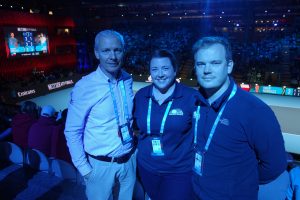
Live ATP Next Gen tennis in Milan: (L/R) Shane Warden, ATP Media; Laura Casey, Gearhouse, production manager; and Hamish Harris, Gearhouse
This latest test follows an initial 1080p/50 HDR production trial during the Nitto ATP Finals in 2017, which put 4K and 1080p/50 HDR side-by-side in a live tennis environment for the first time. The results of that test suggested to ATP Media that it was 1080p/50 HDR rather than 4K HDR that would most efficiently deliver the clear benefits of HDR to its broadcasters and to viewers at home. This follow up test was a next step in delivering a 1080p/50 HDR test feed to broadcasters with a view to gathering feedback for future planning.
The test was also a necessary next step in incorporating HDR and SDR content across all onsite production, including the non-live content available on the EVS network, ENG camera footage, SDR archive and SDR content from other sources. As host broadcaster, ATP Media produces a news service, premium content and bespoke social media content on site for broadcasters managing HDR and SDR in the post production workflow.
The master daily hit list for the edit cabin team in Milan included: 60 second match highlights (two versions for each match); Tennis TV/World Feed match highlights (3’30” and 3’45”); daily highlights (max 4’ across four matches); post-match on court interviews; hotshots (Tennis TV/Amazon versions); tournament show reel (Tennis TV/Amazon); press conferences for newsfeed; and the daily buildup of a 52’ tournament show, to be completed and available immediately after the trophy lift.
Gearhouse Broadcast provided a 1080p HDR facility using Sony HDC-4300 cameras operating in native 1080p HDR and a NAC high speed camera. Mini cameras were Panasonic AW-HE130s, operating in 1080p SDR, with colour space conversion happening on the input to the Grass Valley Kahuna vision switcher with Format Fusion 3 and 4. Routing matrix in the MCR was an Imagine Communications IP3, and the system was controlled by Lawo vsmStudio.
Gearhouse lead vision engineer Hamish Harris told SVG Europe, “there have been a lot of discussions
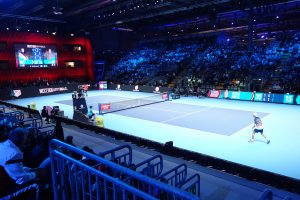
Next Gen match, November 7: Taylor Fritz (USA) vs Liam Caruana (Italy)
about what we wanted to achieve. What HDR standards? How far do we want to go with it? I would say that in terms of cameras, vision switcher, transmission and deliverables we know those areas very well. But in terms of editing in HDR – no-one has ever really done that before.”
“That is the innovation here. That’s the point,” said Shane Warden, ATP Media director of Broadcast & Technology. “Three years ago in London we produced 4K SDR across the live chain. Last year we did the 4K HDR and 1080P50 HDR comparisons. But that was always just the live chain.
“For many recent global sports events this year, the whole live chain was in 4K HDR. But if you actually looked under the hood it was still only the live part that was working that way. All of the replays, the edits, and the deliveries were 1080p SDR. Post production and the EVS network were in their own SDR ecosystem that was fed back in to the live chain and remapped to HDR.
“The other challenge we have addressed is can we create a manageable infrastructure and workflow for a live OB within a very short rig in a fly-away? The goal was to complete an end to end path all the way through, with replay, edit and back to EVS again for the World Feed, and also managing a full rec709 file-based delivery, including the news clips that our broadcasters get as well as Tennis TV, our digital channels, and VOD for Amazon,” said Warden.
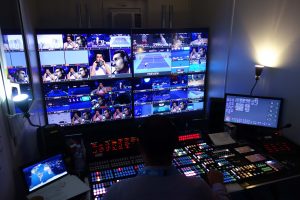
View inside production cabin with full HDR monitoring
“That editorial chain is now all being managed in HDR and we believe it has never been done before in a live OB. So how can we actively manage HDR through the editorial process, especially considering ENG? We’ve got archive; we’ve got other people going out shooting material we don’t have control over. That content might not be in HDR – and it might not even be in a progressive format.
“For our own ENG cameraman going out and shooting scenics, creative match action and interviews, you can’t just say ‘you need to shoot Log’. We have to consider how it fits into the world where our live chain is in HLG and they have a camera that shoots S-log3 – they might even have another camera for B-roll that shoots a different version of Log like a DSLR.
“We needed a simple workflow that takes all of that different media in and mixes it with the EVS record chains to piece together openers and closers and promos as well as ensuring all of the digital and social clips we need to produce look great too,” said Warden.
“We also do something else here on site that’s quite unusual: we build a 52-minute four-part fully-produced and voiced highlights show that we distribute to the world approximately two hours after the trophy lift. We build that show as we go along each day.
“Making sure we’re able to do all that while we’re here obviously adds pressure. We’ve set ourselves quite a task. How can we orchestrate what we’re doing? That’s what we’re achieving in the edit suite here, working in Log across the board but with the guys viewing everything in HDR and working off the HDR pictures – so that we can understand how that looks, especially in relation to the live match action we’re producing. We’ve got to make sure all our post produced material actually has the same look and feel.
“As a result I have had to make a number of LUTs that translate between S-Log3, HLG, and Rec709 that we can use in the post process to correctly re-map the colour spaces. Bringing colour science into live post production, if you like, is the innovation,” said Warden.
“We got together a group of great specialists here,” said Harris, “with Shane and our vision supervisor Luke Chantrell, Gearhouse vision engineer Simon Nichols and Rob Thorn from Sony. We debated the merits of S-Log3, HLG, 709 and 2020. What’s the best thing for us to be doing? Do we do everything in 2020? We did a lot of testing and generated a lot of data, to see what was the best way forward. It was really valuable time. What is the best workflow – being completely agnostic of equipment used?
“If you take a tournament like this where you have 17 cameras, with eight or nine line cameras and
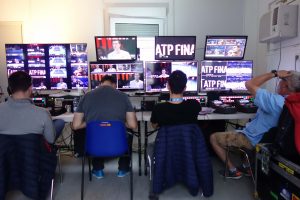
View of one half of the EVS cabin, working with HDR replays
seven minicams, it’s a really good way to work through that HDR workflow, while generating 1080i SDR splits for rightsholders,” Harris continued. “It’s not [a huge event] like Indian Wells, so by design this was an event where we could have the time to work through things, and to find the most efficient way to work.
“The minicams are obviously going to come in progressive SDR, so at what point do we make them HDR? The audio on the coach cameras is embedded; at what point is it best for us to de-embed that whilst also changing the colour space? How do we generate the SDR and the interlace version? Do we do that out of the Kahuna, and what does that look like? The Sony HDRC-4000 conversion box: what does that look like? How do we rack all the pictures in the most efficient way?”
Overall, this test in Milan has helped demonstrate HDR technology’s ability to significantly increase the picture quality of tennis matches for fans at home. The team even feels that the 1080i SDR product has certainly benefitted from this approach. While ATP Media has no current plans to distribute content in native 4K, 4K cameras were used on-site to capture live match action as high resolution acquisition is very much part of the workflow to produce high quality 1080p HDR for broadcasters to distribute as part of a 4K HDR service.
Digging into the HDR edit workflow chain
“There’s been a lot of work with Adobe and EVS in the run-up to this event,” said Warden.
“One thing that came out of our preparatory work was the realisation that we would have to change our codec. We would have to move out of where we were in DNX-land and move into AVC. Knowing I wanted our ENG camera chain to fit into the workflow too, we actually made the decision to go to XAVC, in which the Sony cameras that are often used for ENG can natively record.”
“What we have achieved as a result is a much faster ingest, because we’ve effectively unified our codec all the way through, from ENG and live cameras through the edit and back onto EVS again. That has made things a lot quicker for us.
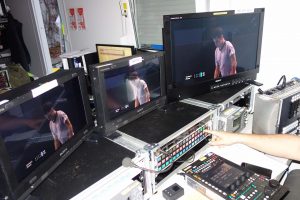
Monitoring HDR inside the MCR cabin – guided by the hand of vision supervisor Luke Chantrell
“Monitoring is the biggest challenge across the board,” continued Warden. “You’ve got to be so careful in HDR: am I looking at something that’s telling me the truth? – small but important changes can make a big difference – killing the fluorescent lighting in the cabin and switching to up-lighting the wall behind the monitors with daylight bulbs from lamps brings consistency in visual colour judgement.
“A lot of this approach to colour management has come from my days in post production for feature films and TV dramas that I did in my past. What we’ve learned here, particularly in the edits, just in terms of monitoring, is this: you’ve got so many sources coming at you, and you have to understand where they’ve come from. You have to make a judgement call on the thing you are creatively producing to make sure it all fits together. We’ve learned that if the monitoring is not spot-on, then you can create some pretty horrific results very easily – because you just can’t see what you’re doing.”
The promise for 1080P/50 HDR production in the future
“HDR is going to make the single biggest difference to the viewing of sport, in my opinion,” Warden continued. “Resolution isn’t going to do that.
“Last November in London we set up two identical Sony screens, absolutely matched, and people could not tell the difference between the 4K HDR and the 1080P/50 HDR. People could not tell the difference — people with a lot of TV experience.
“Here’s my argument. You acquire at 4K, in HDR. You process carefully through the chain, down at 1080p/50. The big difference here is we are going at 50 frames progressive – and that is a massive boost for your enhanced viewing experience.
“We get to the point where we can distribute to any broadcaster in the world, easily, with HDR alongside – and then they can put it out on their 4K HDR channels. And it’s going to look great. That’s the feedback we’re already getting this week.
“We can start to bring the benefits of HDR to consumers way earlier if we go down this route. It’s much more achievable and nowhere near the compromise that people think it is. For a global travelling OB the reduction of complexity in the infrastructure versus a 12G set-up is a colossal saving and I personally think this approach could be applied to other genres like entertainment where HDR and 50P bring such a visual treat.
“It’s an innovation showcase here in Milan; everyone understands there will be innovation on these grounds this week,” Warden concluded. “We’re lucky in that we’ve got great partners in Gearhouse where we have nimble, engaged people, and other partners like Grass Valley and Sony who are all prepared to muck in and make it work, literally right up to TX. It was great to get everyone together in a very collaborative, collegiate environment.”
